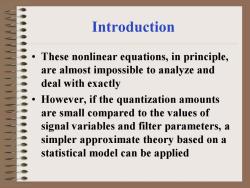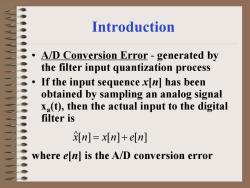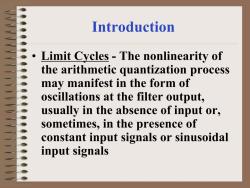电子科技大学:《数字信号处理 Digital Signal Processing》课程教学资源(课件讲稿)Chapter 09 Analysis of Finite Wordlength Effects

Chapter 9 Analysis of Finite Wordlength Effects
Chapter 9 Analysis of Finite Wordlength Effects

Introduction Ideally,the system parameters along with the signal variables have infinite precision taking any value between -co and co In practice,they can take only discrete values within a specified range since the registers of the digital machine where they are stored are of finite length The discretization process results in nonlinear difference equations characterizing the discrete-time systems
Introduction • Ideally, the system parameters along with the signal variables have infinite precision taking any value between -∞ and ∞ • In practice, they can take only discrete values within a specified range since the registers of the digital machine where they are stored are of finite length • The discretization process results in nonlinear difference equations characterizing the discrete-time systems

Introduction These nonlinear equations,in principle, are almost impossible to analyze and deal with exactly However,if the quantization amounts are small compared to the values of signal variables and filter parameters,a simpler approximate theory based on a statistical model can be applied
Introduction • These nonlinear equations, in principle, are almost impossible to analyze and deal with exactly • However, if the quantization amounts are small compared to the values of signal variables and filter parameters, a simpler approximate theory based on a statistical model can be applied

Introduction Using the statistical model,it is possible to derive the effects of discretization and develop results that can be verified experimentally Sources of errors (1)Filter coefficient quantization (2)A/D conversion (3)Quantization of arithmetic operations (4)Limit cycles
Introduction • Using the statistical model, it is possible to derive the effects of discretization and develop results that can be verified experimentally • Sources of errors - (1) Filter coefficient quantization (2) A/D conversion (3) Quantization of arithmetic operations (4) Limit cycles

Introduction Consider the first-order IIR digital filter y[n]=ay[n-1]+x[n] When implemented on a digital machine, the filter coefficient o can assume only certain discrete values approximating the original design value a
Introduction • Consider the first-order IIR digital filter y[n]= αy[n-1]+x[n] α ^ • When implemented on a digital machine, the filter coefficient α can assume only certain discrete values approximating the original design value α

Introduction The desired transfer function is H(z)= 1-az-1-5-a The actual transfer function implemented is e)-:2a which may be much different from the desired transfer function H()
Introduction • The desired transfer function is α α − = − = − z z z H z 1 1 1 ( ) − α = z z H(z) ^ ^ which may be much different from the desired transfer function H(z) • The actual transfer function implemented is

Introduction Thus,the actual frequency response may be quite different from the desired frequency response Coefficient quantization problem is similar to the sensitivity problem encountered in analog filter implementation
Introduction • Thus, the actual frequency response may be quite different from the desired frequency response • Coefficient quantization problem is similar to the sensitivity problem encountered in analog filter implementation

Introduction A/D Conversion Error generated by the filter input quantization process If the input sequence x[n]has been obtained by sampling an analog signal xa(t),then the actual input to the digital filter is n]x(n]+eln] where en]is the A/D conversion error
Introduction • A/D Conversion Error - generated by the filter input quantization process • If the input sequence x[n] has been obtained by sampling an analog signal xa(t), then the actual input to the digital filter is x[n] = x[n]+ e[n] ^ where e[n] is the A/D conversion error

Introduction Arithmetic Quantization Error-For the first-order digital filter,the desired output of the multiplier is vIn]=ay(n-1] Due to product quantization,the actual output of the multiplier of the implemented filter is n]ayIn-1]+ea[n]=v[n]+ealn] where ealn]is the product roundoff error
Introduction • Arithmetic Quantization Error - For the first-order digital filter, the desired output of the multiplier is v[n] =αy[n −1] v[n] y[n 1] e [n] v[n] e [n] = α − + α = + α ^ where eα[n] is the product roundoff error • Due to product quantization, the actual output of the multiplier of the implemented filter is

Introduction Limit Cycles-The nonlinearity of the arithmetic quantization process may manifest in the form of oscillations at the filter output, usually in the absence of input or, sometimes,in the presence of constant input signals or sinusoidal input signals
Introduction • Limit Cycles - The nonlinearity of the arithmetic quantization process may manifest in the form of oscillations at the filter output, usually in the absence of input or, sometimes, in the presence of constant input signals or sinusoidal input signals
按次数下载不扣除下载券;
注册用户24小时内重复下载只扣除一次;
顺序:VIP每日次数-->可用次数-->下载券;
- 电子科技大学:《数字信号处理 Digital Signal Processing》课程教学资源(课件讲稿)Chapter 07 Digital Filter Design.pdf
- 电子科技大学:《数字信号处理 Digital Signal Processing》课程教学资源(课件讲稿)Chapter 06 Digital Filter Structures.pdf
- 电子科技大学:《数字信号处理 Digital Signal Processing》课程教学资源(课件讲稿)Chapter 05 Digital Processing of Continuous-Time Signals.pdf
- 电子科技大学:《数字信号处理 Digital Signal Processing》课程教学资源(课件讲稿)Chapter 04 Frequency-domain Representation of LTI Discrete-Time Systems.pdf
- 电子科技大学:《数字信号处理 Digital Signal Processing》课程教学资源(课件讲稿)Chapter 03 Transform-Domain Representation of Discrete-Time Signals.pdf
- 电子科技大学:《数字信号处理 Digital Signal Processing》课程教学资源(课件讲稿)Chapter 02 Discrete-Time Signals and Systems.pdf
- 电子科技大学:《数字信号处理 Digital Signal Processing》课程教学资源(课件讲稿)Chapter 01 Continuous-time Signals and Systems.pdf
- 电子科技大学:《数字信号处理 Digital Signal Processing》课程教学资源(课件讲稿)Chapter 00 Introduction.pdf
- 电子科技大学:《微电子器件》课程教学资源(思政教案)高频晶体管设计.pdf
- 电子科技大学:《微电子器件》课程教学资源(思政教案)MOSFET发展方向.pdf
- 电子科技大学:《微电子器件》课程教学资源(思政教案)大注入效应.pdf
- 电子科技大学:《微电子器件》课程教学资源(思政教案)绪论、微电子技术发展现状.pdf
- 电子科技大学:《微电子器件》课程教学资源(教学大纲)Microelectronic Devices.pdf
- 电子科技大学:《移动通信系统》课程教学资源(课件讲稿)第七章 未来移动通信系统及其增强技术.pdf
- 电子科技大学:《移动通信系统》课程教学资源(课件讲稿)第四章 抗衰落和链路性能增强技术.pdf
- 电子科技大学:《移动通信系统》课程教学资源(课件讲稿)第六章 GSM及其增强移动通信系统.pdf
- 电子科技大学:《移动通信系统》课程教学资源(课件讲稿)第五章 蜂窝组网技术(移动通信网的基本概念、频率复用和蜂窝小区、多址接入技术).pdf
- 电子科技大学:《移动通信系统》课程教学资源(课件讲稿)第二章 移动通信电波传播与传播预测模型.pdf
- 电子科技大学:《移动通信系统》课程教学资源(课件讲稿)第三章 移动通信中的信源编码和调制解调技术.pdf
- 电子科技大学:《移动通信系统》课程教学资源(课件讲稿)第一章 概述(主讲:雷霞).pdf
- 电子科技大学:《数字信号处理 Digital Signal Processing》课程教学资源(课件讲稿)Chapter 10 Multirate Digital Signal Processing.pdf
- 电子科技大学:《数字信号处理 Digital Signal Processing》课程教学资源(课件讲稿)Chapter 11 Applications of Digital Signal Processing.pdf
- 电子科技大学:《数字通信基础 Digital Communications》课程教学资源(课件讲稿,图片版)About.pdf
- 电子科技大学:《数字通信基础 Digital Communications》课程教学资源(课件讲稿,图片版)Chapter 01 Introduction 1.1 Exampls.pdf
- 电子科技大学:《数字通信基础 Digital Communications》课程教学资源(课件讲稿,图片版)Chapter 01 Introduction 1.2 Diagram and elements of Comm.Sys.pdf
- 电子科技大学:《数字通信基础 Digital Communications》课程教学资源(课件讲稿,图片版)Chapter 01 Introduction 1.3 Digital Comm.Sys.pdf
- 电子科技大学:《数字通信基础 Digital Communications》课程教学资源(课件讲稿,图片版)Chapter 01 Introduction 1.4 Channels and their characteristics.pdf
- 电子科技大学:《数字通信基础 Digital Communications》课程教学资源(课件讲稿,图片版)Chapter 04 Information source and source coding 4.1 ADC and PCM.pdf
- 电子科技大学:《数字通信基础 Digital Communications》课程教学资源(课件讲稿,图片版)Chapter 04 Information source and source coding 4.2 Modeling of digital source.pdf
- 电子科技大学:《数字通信基础 Digital Communications》课程教学资源(课件讲稿,图片版)Chapter 05 Digital transmission through the AWGN channel 5.1 Geometric rep.of the sig waveforms.pdf
- 电子科技大学:《数字通信基础 Digital Communications》课程教学资源(课件讲稿,图片版)Chapter 05 Digital transmission through the AWGN channel 5.2 Pulse amplitude modulation.pdf
- 电子科技大学:《数字通信基础 Digital Communications》课程教学资源(课件讲稿,图片版)Chapter 05 Digital transmission through the AWGN channel 5.3 2-d signal waveforms.pdf
- 电子科技大学:《数字通信基础 Digital Communications》课程教学资源(课件讲稿,图片版)Chapter 05 Digital transmission through the AWGN channel 5.4 M-d signal waveforms.pdf
- 电子科技大学:《数字通信基础 Digital Communications》课程教学资源(课件讲稿,图片版)Chapter 05 Digital transmission through the AWGN channel 5.5 Opt.reception for the sig.in AWGN.pdf
- 电子科技大学:《数字通信基础 Digital Communications》课程教学资源(课件讲稿,图片版)Chapter 05 Digital transmission through the AWGN channel 5.5.2 Opt.reception for the sig.in AWGN.pdf
- 电子科技大学:《数字通信基础 Digital Communications》课程教学资源(课件讲稿,图片版)Chapter 05 Digital transmission through the AWGN channel 5.5.3 Opt.reception for the sig.in AWGN.pdf
- 电子科技大学:《数字通信基础 Digital Communications》课程教学资源(课件讲稿,图片版)Chapter 05 Digital transmission through the AWGN channel 5.6.1 Optimal receivers and probs of err.pdf
- 电子科技大学:《数字通信基础 Digital Communications》课程教学资源(课件讲稿,图片版)Chapter 05 Digital transmission through the AWGN channel 5.6.2 Optimal receivers and probs of err.pdf
- 电子科技大学:《数字通信基础 Digital Communications》课程教学资源(课件讲稿,图片版)Chapter 05 Digital transmission through the AWGN channel 5.6.3 OptRecv-MPSK-QAM-MFSK.pdf
- 电子科技大学:《数字通信基础 Digital Communications》课程教学资源(课件讲稿,图片版)Chapter 05 Digital transmission through the AWGN channel 5.6.4 Optimal receivers and probs of err.pdf
